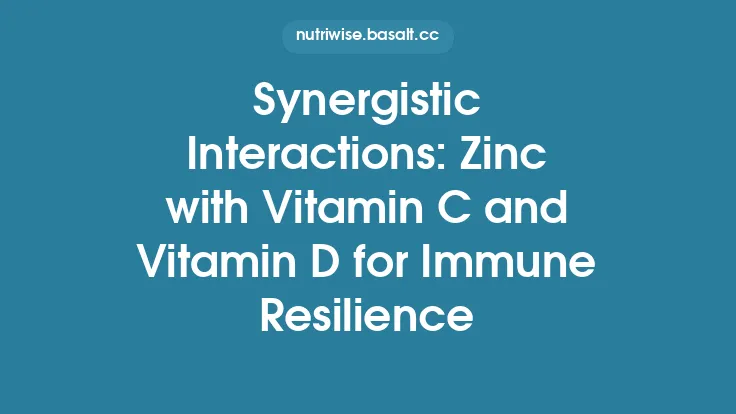Copper and zinc are two of the most abundant trace elements in the human body, and both are indispensable for a robust immune system. While each mineral has its own distinct biochemical responsibilities, their interaction creates a finely tuned network that enhances immune surveillance, pathogen clearance, and the resolution of inflammation. Understanding how copper and zinc cooperate at the molecular, cellular, and systemic levels provides valuable insight into why balanced intake of these micronutrients is essential for maintaining immune competence throughout life.
Copper’s Role in Immune Cells
Copper functions as a catalytic co‑factor for a variety of enzymes that are directly involved in immune processes.
- Cytochrome c oxidase – the terminal enzyme of the mitochondrial electron transport chain, relies on copper to generate ATP. Adequate ATP supply is critical for the rapid proliferation of lymphocytes during an immune response.
- Superoxide dismutase (Cu/Zn‑SOD) – a metallo‑enzyme that converts the superoxide radical (O₂⁻) into hydrogen peroxide (H₂O₂). Although the primary focus of this article is not antioxidant defense, the detoxification of reactive oxygen species (ROS) created during the respiratory burst of phagocytes is essential for preventing collateral tissue damage while allowing microbes to be killed efficiently.
- Ceruloplasmin – a copper‑binding plasma protein that oxidizes Fe²⁺ to Fe³⁺, facilitating iron transport. By regulating iron availability, ceruloplasmin indirectly limits the growth of iron‑dependent pathogens.
- Lysyl oxidase – a copper‑dependent enzyme that cross‑links collagen and elastin, contributing to the structural integrity of mucosal barriers that serve as the first line of defense against invading organisms.
In innate immune cells such as neutrophils and macrophages, copper is mobilized to the phagolysosome where it participates in the generation of microbicidal copper ions. These ions can disrupt bacterial enzymes, destabilize membranes, and interfere with nucleic acid synthesis, thereby augmenting the killing capacity of phagocytes.
Zinc’s Contribution to Immune Defense
Zinc is equally versatile, acting as a structural and catalytic component in over 300 enzymes and transcription factors. Its immunological functions include:
- DNA synthesis and cell division – Zinc‑finger transcription factors (e.g., NF‑κB, AP‑1) regulate the expression of cytokines, chemokines, and surface receptors essential for immune cell activation and differentiation.
- Thymic hormone (thymulin) activity – Zinc is required for the biological activity of thymulin, a hormone that promotes T‑cell maturation and the development of a functional adaptive immune repertoire.
- Natural killer (NK) cell cytotoxicity – Adequate zinc levels sustain the granule exocytosis pathway that NK cells use to eliminate virally infected or transformed cells.
- Barrier integrity – Zinc stabilizes tight junction proteins in epithelial layers, reducing pathogen translocation across mucosal surfaces.
- Modulation of inflammatory signaling – By influencing the activity of phosphatases such as protein tyrosine phosphatase 1B (PTP1B), zinc can temper excessive cytokine production, preventing hyperinflammatory states.
Zinc deficiency is one of the most common micronutrient deficiencies worldwide and is associated with increased susceptibility to respiratory, gastrointestinal, and dermal infections.
Molecular Basis of Copper–Zinc Interaction
The synergy between copper and zinc emerges from several interrelated mechanisms:
- Shared Enzymatic Complexes – The most prominent example is Cu/Zn‑SOD, where both metals occupy distinct active‑site positions. The enzyme’s efficiency depends on the precise stoichiometric balance of copper and zinc; an excess of one metal can displace the other, reducing enzymatic activity.
- Regulation of Metal Transporters – The divalent metal transporter 1 (DMT1) and the zinc transporter families (ZIP and ZnT) exhibit cross‑regulatory behavior. Elevated intracellular copper can up‑regulate ZIP8, a transporter that imports zinc into immune cells, thereby ensuring sufficient zinc availability for transcriptional programs. Conversely, zinc can modulate the expression of copper‑transporting ATPases (ATP7A/B), influencing copper efflux and intracellular distribution.
- Metallothionein (MT) Buffering – MT proteins bind both copper and zinc with high affinity, acting as intracellular reservoirs. During an immune challenge, cytokine signaling triggers MT synthesis, which sequesters excess free copper (preventing toxicity) while releasing bound zinc to support transcription factor activation.
- Reciprocal Antimicrobial Strategies – Macrophages employ a “nutritional immunity” tactic: they pump copper into phagosomes to poison microbes while simultaneously limiting zinc availability to the same compartment, as many pathogens require zinc for enzymatic function. The coordinated regulation of copper influx and zinc efflux within the phagosome exemplifies functional synergy that maximizes antimicrobial efficacy while protecting host cell components.
Impact on Innate Immunity
Phagocytosis and Respiratory Burst – Copper accumulation in the phagolysosome enhances the oxidative burst by providing a substrate for copper‑dependent oxidases that generate hydroxyl radicals. Simultaneously, zinc ensures the proper assembly of NADPH oxidase complexes and stabilizes the membrane potential required for electron transport.
Complement Activation – Zinc is a co‑factor for several complement proteins (e.g., C1q, C3). Adequate zinc levels facilitate the formation of the C3 convertase, amplifying opsonization and lysis of pathogens. Copper, through ceruloplasmin, modulates the availability of iron, indirectly influencing complement synthesis in the liver.
Pattern Recognition Receptor (PRR) Signaling – Toll‑like receptors (TLRs) and NOD‑like receptors (NLRs) rely on zinc‑finger motifs for ligand binding and downstream signaling. Copper can modulate the redox environment that influences PRR conformation, thereby fine‑tuning pathogen detection.
Influence on Adaptive Immunity
T‑Cell Development and Differentiation – The thymus is a zinc‑rich organ; zinc deficiency impairs thymulin activity, leading to reduced CD4⁺ and CD8⁺ T‑cell output. Copper, via its role in mitochondrial respiration, supports the metabolic shift from oxidative phosphorylation to glycolysis that activated T cells undergo during clonal expansion.
B‑Cell Antibody Production – Zinc regulates the transcription of activation‑induced cytidine deaminase (AID), a key enzyme for class‑switch recombination and somatic hypermutation. Copper, through its involvement in oxidative stress responses, influences the survival of plasma cells in the bone marrow niche.
Cytokine Balance – A balanced copper‑zinc status promotes a cytokine milieu that favors protective Th1 responses (e.g., IFN‑γ) while limiting excessive Th17 or pro‑inflammatory IL‑6 production. This equilibrium is crucial for clearing intracellular pathogens without precipitating tissue damage.
Clinical Implications and Deficiency States
- Copper Deficiency – Rare but can arise from malabsorption (e.g., Menkes disease) or excessive zinc supplementation, which induces metallothionein that preferentially binds copper, reducing its serum levels. Clinical manifestations include neutropenia, impaired phagocytic function, and increased infection risk.
- Zinc Deficiency – More prevalent, especially in low‑income regions, the elderly, and individuals with chronic gastrointestinal disorders. Symptoms encompass delayed wound healing, thymic atrophy, lymphopenia, and heightened susceptibility to pneumonia and diarrheal disease.
- Combined Deficiency – When both copper and zinc are insufficient, the synergistic deficits compound, leading to profound immunosuppression. Laboratory evaluation should include serum copper, ceruloplasmin, zinc, and metallothionein levels, alongside functional immune assays (e.g., NK cell activity, oxidative burst testing).
- Therapeutic Use of Copper‑Zinc Supplements – Clinical trials in pediatric and adult populations have demonstrated that combined copper‑zinc supplementation can reduce the duration of common cold symptoms and lower the incidence of respiratory infections, provided that dosing respects the established tolerable upper intake levels (ULs): 10 mg/day for copper and 40 mg/day for zinc in adults.
Considerations for Dietary Sources
While the article does not delve into detailed dietary planning, it is worth noting that a variety of whole foods naturally provide both copper and zinc in bioavailable forms:
- Animal‑derived proteins – Liver, shellfish (especially oysters), and red meat are rich in copper and zinc, with the mineral ratios favoring synergistic absorption.
- Plant‑based options – Legumes, nuts (e.g., cashews, almonds), seeds (pumpkin, sesame), and whole grains contain appreciable amounts of both trace elements, though phytates can impede absorption; cooking methods such as soaking, sprouting, or fermentation can mitigate this effect.
- Fortified products – Certain breakfast cereals and nutrition bars are fortified with copper and zinc, offering a convenient means to meet daily requirements, especially for populations with limited animal protein intake.
Future Research Directions
The copper‑zinc partnership in immunity remains an active field of investigation. Emerging areas include:
- Systems‑biology modeling – Integrating transcriptomic, proteomic, and metallomic data to map the dynamic flux of copper and zinc during acute infection versus chronic inflammation.
- Nanoparticle delivery – Engineering copper‑zinc oxide nanoparticles that can target immune cells, delivering trace elements directly to phagosomes to boost antimicrobial activity while minimizing systemic exposure.
- Genetic polymorphisms – Exploring how variations in genes encoding metal transporters (e.g., SLC30A, ATP7A) influence individual susceptibility to infections and response to supplementation.
- Microbiome interactions – Investigating how gut microbial communities modulate host copper and zinc status, and conversely, how trace element availability shapes microbial composition and pathogenicity.
Continued interdisciplinary research will refine our understanding of how copper and zinc co‑operate, ultimately informing evidence‑based guidelines for optimizing immune health across diverse populations.





